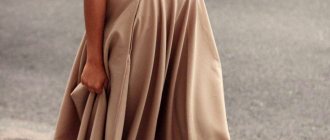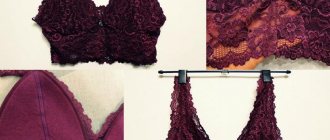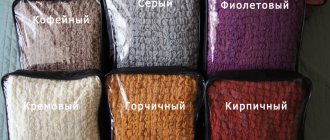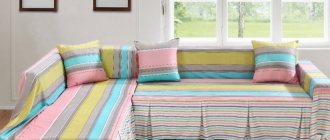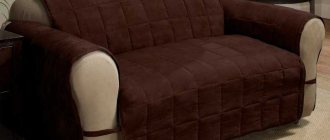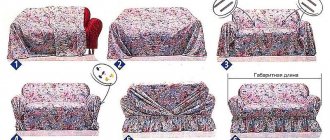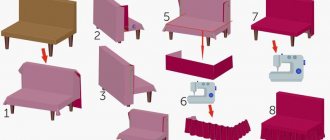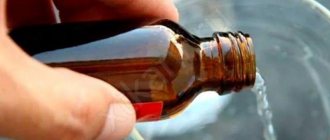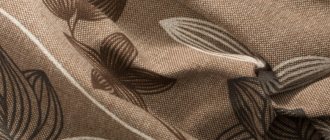Covers for upholstered furniture extend the life of its use or allow you to breathe new life into old furniture without resorting to rather complex and expensive restoration. Any housewife with a sewing machine can sew a decent sofa cover with her own hands. For example, how to sew a sofa cover in one evening, see video tutorial:
However, depending on the design of the sofa, its purpose and how it is used in the house, different types of covers may be best for a given sofa. Finally, the most in-depth lesson concerns one specific piece of furniture, and what to do if your sofa is just like that? Or do you want a completely different case for exactly the same thing? This article discusses how to design and sew a cover for a sofa of any type yourself, as long as you imagine how you want to see your favorite rookery.
Sofas with covers
Without pattern
It is believed that a cover for a sofa is sewn in the same way as for an armchair. This is true when it comes to a cut case. But if you make a cover for a chair without a pattern, it will always get confused: the area of adhesion between the fabric of the cover and the seat and back is small. But it is quite possible to sew a sofa cover without a pattern. And it can look amazing. Just don’t be fooled: firstly, it will take a lot of fabric. The cut will need a width of approx. 5 seat widths and 2.5-2.7 sofa lengths. Secondly, the work will be quite painstaking; for an everyday case it would probably be easier to develop a pattern (see below). But let us emphasize: sewing the same luxurious case with cutting will be much more difficult. And if a sofa has a camber of armrests and a curved/inclined backrest, then without solid sewing experience it is hardly possible. And without a pattern - without significant problems. At the cost of increased fabric consumption.
How to sew a sofa cover without a pattern is shown in the figure:
How to sew a sofa cover without a pattern
Let us give some key explanations. At pos. 3 shows the reinforcement of the seams at the border of the seat with the back and armrests (see below); a cover without reinforced seams will constantly come off. After marking for the reinforced seams, the cover blank is removed, the seams are sewn with reinforcement, the blank is put back on, the reinforced seams are straightened along the contour of the seat, secured with pins (not safety pins) on the sofa and work continues.
Further, according to pos. 4, form decorative folds on the facade. They are swept away and secured to the sofa with pins or pushpins. After this, the rear folds are formed in the same way, pos. 5.
Note: at the stage according to pos. The 4 folds on the front overhang of the seat must be assembled so that the fabric of the cover lies flat along the curb line, but without noticeable tension. Why - see below.
Now comes the hard part. The fact is that a cover of this type is always made with an elastic band so that it can be removed for washing or, conversely, put on on special occasions - such covers are mostly ceremonial in middle-income homes. The elastic is inserted along the line of the sofa border (see below), but try to achieve a neat gathering of its sleeve if you sew it (from the inside out, of course) onto a piece removed from the sofa! And without this, the whole look is lost. Here you will have to work with your hands or, perhaps, with a manual mini sewing machine. In this case, the sleeve (drawstring) stripe under the elastic band is done as follows. way:
- We push the folds on the sidewalls along the border line to the back corners and sweep them onto a living thread;
- If the sofa has a camber of armrests and/or a tilt/bend of the back, measure its overall dimensions, i.e. dimensions of the projection of the sofa on the floor (see, for example, item 6);
- We cut out 2 strips of fabric with a width of 5 cm for the drawstrings, the same as for the cover. One drawstring - U-shaped, on the front and sides. The second is straight to the rear;
- We apply a U-shaped drawstring, secured with pins, along the line of overall dimensions so that the tails at the back are equal in length, and mark the front corners on the drawstring;
- Remove the workpiece and turn it inside out (be careful not to rip off the back corners!);
- We sew the P-drawstring from the inside out: first along the front corners, then we sew it along the front, then we sew the sides;
- We also sew on the back straight drawstring;
- We thread the elastic through and sew its edges together with an overlap of approx. 5 cm. Elastic length – approx. 15% less than the length of the perimeter of the sofa along the border line;
- Remove the basting of folds on the back corners;
- We turn the workpiece onto the face and manually evenly gather the folds over the elastic band. Or unevenly, that’s up to your taste;
- We fix the resulting decorative folds with stitching (do not grab the elastic!) on the front and sides separately. Previously formed monumental folds on the armrests are not stitched! To tighten the cover if necessary, just stretch the back drawstring and the unstitched front corners;
- We put the cover on the sofa (item 6) and admire it. Or we quarrel, tear everything apart and do it again.
Note: the work of sewing drawstrings and gathering folds over the elastic band is greatly simplified if you have a mini sewing machine for hanging sewing - then you don’t have to remove the workpiece from the sofa.
About reinforced seams
Reinforcing the seams in a sofa cover may, firstly, be necessary not only along the contour of the seat. Secondly, reinforced seams can also serve as decorative edgings.
The first method of strengthening a seam is illustrated by pos. 1-5 fig. It is applicable for cut covers made of fairly dense fabrics. So that the insert sleeve with the cord does not wrinkle, it is stitched by slightly pulling it towards itself and bending it on the edge of the machine table (item 3): let it pull itself, and the sleeve folds itself. Fold only its very end with your fingers, pos. 4.
Ways to reinforce seams in a sofa cover
If the fabric of the cover is thin or it is sewn without a pattern, use a seam reinforcement scheme according to pos. 6. Hem allowance 2x30 mm. In the case of sewing a cover without a pattern, the allowance must be pinned together with safety pins already when laying out the fabric on the seat (item 3 in the figure with the stages of sewing without a pattern). There is a nuance here: the reinforced seam along the contour of the seat is always turned on the wrong side: this way it does not feel like what you are sitting on, and the cover collects less dust and requires cleaning less often. Therefore, stages 1-3 in Fig. with sewing stages without a pattern, it is made with the fabric inside out, and turned face up for stages 4-6.
Decoration options
It is not difficult to sew covers for a sofa; in addition, they can be decorated in an original way. The decor depends on the style in which the product was originally conceived, as well as on the material of manufacture. A properly designed bedspread should fit organically into the surrounding environment and not look like an alien element. Most often, modern needlewomen use for decoration:
- laces;
- ribbons;
- bows;
- decorative rope;
- embroidery;
- applique.
The simplest design option is a wide braid along the edge. It can be a contrasting color compared to the blanket or, conversely, a similar shade. Silk bedspreads are most often decorated with embroidery. Popular designs for sofa covers are floral and geometric patterns, as well as (for experienced craftswomen) designs in Oriental, Japanese or Chinese styles.
Stages of repairing a sofa with your own hands, taking into account the specifics of the malfunction
If there are animals at home, you should not decorate the cover for the corner sofa with pom-poms or tassels. Such decoration will definitely attract the attention of pets and will soon lose its original appearance. Bedspreads for a baby crib are usually not decorated with sequins, beads and beads; If these small elements are not sewn carefully, the child can easily tear them off and swallow them.
The main requirement for decor is a reasonable combination of beauty and practicality. If a needlewoman plans to frequently wash the bedspread in a machine, the most suitable option would be an applique or braid along the edge. Embroidery made from satin ribbons is very popular. This is the easiest way to decorate.
To make the applique you will need unnecessary scraps of fabric. First you should think about the composition and draw a simple sketch on paper. Next, you need to cut out the necessary shapes and lay them out on the case to see how the finished decoration will look.
Experienced needlewomen usually sew decorative details with a hidden seam, which is almost invisible from the front side. A novice craftswoman can fix the appliqué details on the material using a special textile glue that does not collapse when the product is washed. This decoration will look beautiful if the room is decorated in Provence (country) style. The most popular motif for applique is an abstract geometric pattern (for example, alternating circles, rectangles, ovals of different colors and sizes).
Products for a baby crib (for girls) can be decorated independently with bows or flowers made from satin ribbons. They are sewn along the perimeter of the product or randomly, at different points of the bedspread. The material for work should be scorched over a fire using a lighter so that the ends do not fray.
A bedspread that a needlewoman has made herself will give the home a unique coziness and help create a warm atmosphere in the room. DIY sofa covers will suit interiors decorated in a variety of styles, from country to classic, and will last a long time if made from high-quality material.
We will reveal it locally
Cutting a sofa cover locally is technologically simpler than sewing a dress cover without a pattern, and developing patterns for the cover, and is also quite economical: up to 25% of the cutting area is wasted, depending on the thickness of the seat and backrest. This method is suitable for simple shaped sofas.
With the opening in place, the trace is sewn. sofa covers:
- Covers for geometrically simple, non-folding sofas without armrests, common in modern style interiors, and for book sofas, see below.
- Linings (case covers) made of technical fabric for dress covers sewn without a pattern, so as not to bother with the pattern of the cover case.
- Everyday saving covers (item 3 in the figure), incl. on the sofa in a formal cover.
How to sew a sofa cover with cutting in place is shown in pos. 1 and 2 pictures:
Sewing a sofa cover with cutting to place
Recommendations to reinforce the seams with wooden inserts are most likely either an unqualified translation of the original source, or simply an intuitive guess. In fact, using suitable pieces of wood, folds are formed to reinforce the seams with a turn, see above. If the pieces of wood are left in the seams, they will soon rub through both the cover and the upholstery of the sofa. At pos. 4 gives examples of how to decoratively decorate the covers of the wings of the cover on the armrests; Of course, your own solutions are also possible. If covers are required only for armrests, they are designed in a similar way; In this case, fabric waste is zero or almost zero.
Note: it is advisable to sew covers separately for the armrests and, possibly, the back of the sofa if it is in a public place or, say, in a frequently visited hallway or on the veranda of a private house.
About the role of the case cover
The undercover, firstly, improves the adhesion of the cover made of beautiful but slippery fabric to the sofa. In this case, it is sewn from thin cotton fabric, for example, linen. Old yellowed sheets are perfect; a slipcover made from them holds the satin cover on the faux leather sofa as if sewn on.
Another purpose of the cover is to protect the sofa itself from dirt and grease. If the sofa is leather, this is very important. In this case, the undercover is sewn in 3 layers: a fairly dense technical fabric (linen canvas, matting; you can use propylene from bags) is placed on the upholstery of the sofa, followed by a layer of padding polyester or, better yet, holofiber, and the cover holds the canvas, as in the previous one. case.
For a book
Thanks to Ikea, everyone now knows what a Eurobook sofa is, see figure:
Construction of a Eurobook sofa
It is not said as a reproach: book sofas are indeed very comfortable, and in small one- or two-room apartments they are sometimes irreplaceable. It is only necessary to note that sofa beds of exactly the same design were produced in the USSR back when not every average person in Europe had heard of the embryo of the EU in the form of Benelux. True, sofa sofas were supplied to furniture stores in single copies, which had a small factory defect. Conditional ones were distributed at the top according to orders or were bought up through connections by those admitted to the hairy hands of the Ivan Ivanovichs. According to rumors, just such a sofa bed stood in the Dnepropetrovsk (in his hometown) apartment of the most Ivan Ivanovich of all Ivan Ivanovichs - the unforgettable Leonid Ilyich. Quite plausible: he was a simple and good man, only weak for his post. This is probably why they chose him when the bald clown in power turned out to be no better than the mustachioed monster. But let's get back to the topic.
You need at least 2 separate covers for a sofa book, or 3 if you want the folded back to not stand out in color. You may also need to cover the armrests; then you will need 4 or 5 separate covers. Covers for the armrests of a book sofa are cut in place, as described above, but with one condition: at the bottom, under the underside of the armrests, they must be tightly fastened with a zipper with large teeth, otherwise the mechanism will always be tighten and soon break; The option with a rubber band does not help with this. In fact, covers for the armrests of book sofas are their sore spot, which, as far as we know, has not yet been cured by anyone.
There are no problems with covers for the mattresses of the sofa-book. The pattern is given on the left in Fig. with sizes for popular models:
How to sew a cover for a sofa book
How the corners are stitched is shown in the center. The cover of the book sofa is tightened with an elastic band (on the right in the figure), but first you need to mark the armhole in place along the mechanism. It is a simple straight cut for the boss that fits into the cutout of the lever and is edged with trouser braid; Bias tape wears out soon. The armhole is pulled together from the bottom with an elastic band. To put on or take off the cover, you will first need to remove the linkage; this is done simply by hand without tools, see the instructions for the sofas.
Manufacturing materials and tools
A sofa cover can be made from different fabrics. The choice depends on individual preferences. The easiest way to care for fleece and tapestry. They practically do not fade in the sun, they can be washed in an automatic machine.
| Velours | Looks impressive, but attracts dust and static electricity |
| Flock | Externally similar to velor, but costs less and has a shorter service life |
| Microfiber | The fabric is easy to care for, but easily absorbs and retains foreign odors for a long time. |
| Cotton | Natural fabric, does not cause allergic reactions, can be used for covers on children's furniture. Disadvantages: fades when washed and fades in the sun |
| Jacquard | Durable fabric that lasts a long time, maintaining color and structure. But the material can become very wrinkled and stretched during automatic spinning during machine washing. |
Ways to get rid of bedbugs in a sofa, how to choose the best remedy
The main requirements for the material for sewing a cover are practicality and hypoallergenicity (especially if you need to sew a blanket for children). Ease of care and cleaning is also very important. Color fastness matters. And, of course, it’s good when the fabrics are pleasant to the touch, this creates additional comfort.
You should purchase fabric in a store so that you have enough to spare when sewing. If there is still material left after cutting, you can use it to sew decorative sofa pillows to match the cover.
Velours
Jacquard
Microfiber
Flock
Cotton
According to the pattern
A sofa cover, sewn according to a self-made pattern, first, makes the most complete use of the cutting area. Considering that fabric for a beautiful case costs somewhere between $30-$50, this is important. Secondly, only using a homemade pattern can you sew a truly original and unique product.
Note: the sofa border line is located either 10-25 cm above the floor, or at the height of the transition of the vertical surfaces of the armrests into inclined ones.
Learning how to make patterns for upholstered furniture covers is not that difficult; much easier than for clothes. To get started, you can watch a video course on designing covers for upholstered furniture:
Video: lesson on cutting furniture covers
When starting to create patterns without experience or with initial experience in sewing, there are one more things to consider. To create a pattern for a sewing piece according to size, you will have to, firstly, remove at least a dozen of them from the sofa (see on the left in the figure), but this does not solve the matter.
Measuring diagram for creating a sofa cover pattern
For example, for the same sample, you will also need to remove the length of the generatrix (curvilinear part) of the backrest and the length of the curves of the armrests. If the sofa is of an extremely simple shape, the pattern can be made from rectangles (on the right in the figure), but in both cases you need to take into account the tightening of the fabric, and here you can’t do without experience. Professional seamstresses in production have a saying: “You can tighten everything, but how will it wear?” A cover made of stretched fabric will not look good, and will soon fall apart.
For beginners, it is better to create patterns for a cover for a sofa or other upholstered furniture and sew it using a 3-stage method. By the way, famous couturiers readily use it, but they buy special paper. In general, the same as described below, but in rolls and not printed. The procedure is:
- Glue newspapers into panels of the required size;
- Having placed the cloth on the surface to be worked on, for example, a seat, smoothly smooth it from the middle to the edges. If you can’t get rid of the wrinkles on newsprint, stop! Here is the edge of the current part and the beginning of the next one;
- A paper pattern is cut out along the marked edges of the part;
- Using newspaper patterns, the cover is cut with double or triple the seam allowance;
- Sweep and adjust the parts of the cover in place, achieving an even fit;
- Using the fitted parts of the cover, cut out patterns for the parts of the cover from thick glued paper (for example, drawing paper);
- Sew and put on the cover, and then the cover.
The essence of this method is that thin, unglued paper stretches until it breaks or wrinkles in much the same way as rigid fabric. That is, if the newspaper was able to be flattened in situ, then the fabric will cover it evenly, but without constriction. You just need to glue the newspapers into sheets so that the glue seam does not prevent the paper from stretching. Once upon a time, for this purpose, tailors glued newspapers with gum arabic, which gave an elastic seam, and in our time its full-fledged replacement is an office adhesive pencil. It is advisable to glue it “poke”, like the tailors of old: we press the pencil to the paper, turn it, apply the glued one. The next poke is after 5-7 cm.
What to do with the angle
The most difficult thing is to sew a cover for a corner sofa. It is always sewn in parts, and here there are 2 options. The first is an attached corner section, on the left to the next. rice. You need to sew 5 covers: for the main section, the side section, the back, the armrests, and sew them with a reinforced seam.
Covers for corner sofas
The second is an insertable corner section (on the right in the figure) or a sofa with a solid structure (in the center). In this case, the covers are cut and sewn separately onto the wings and corner of the sofa and stitched together from the inside out. The main thing here is to hide the seams between the wings and the corner, because... they will fit on the seat and back. The best way to do this is pleated, in the center in the figure, but this is a complicated matter, and factory pleated fabrics are not much easier to work with. Another is to choose the color of the cover fabric so that the seam is lost in it, on the right in Fig. And there is one more trick.
More about the seam
You can make the front seam much more hidden if you sew it with a tightening fit on the fabric. If the entire cover is sewn from a fairly rough material, for example, canvas in a rustic-style interior, then all its seams should be seams. How to sew a seam with a seat at home on a regular sewing machine, see the final video:
